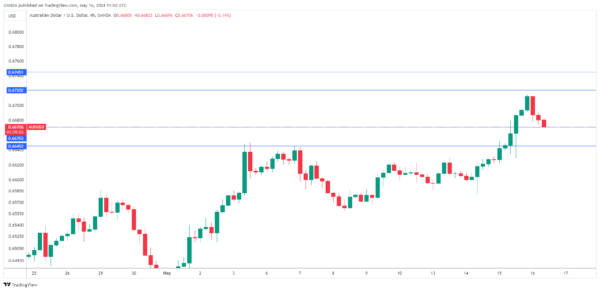The Australian dollar is lower on Thursday after surging 0.98% a day earlier. AUD/USD is currently trading at 0.6671, down 0.33% on the day.
Australian job growth rebounds but unemployment rate rises
Australian employment bounced back in April with an increase of 38,500 after a decline of 5,900 in March and higher than the market estimate of 23,700. However, the rebound was not all that impressive, as full-time employment declined by 6,100. The unemployment rate rose to 4.1%, up from 3.9% and its highest level since January.
The Reserve Bank of Australia needs to see weaker data before it can lower interest rates, and this employment report could point to some cracks in the labor market. If labour data continue to soften, a rate cut before the end of the year would be on the table. Wage growth eased in the first quarter, which would point to inflation heading lower.
US CPI drops to 3.4%
US CPI dipped to 3.4% y/y in April, down from 3.5% in March and matching the market estimate. Monthly, CPI ticked lower to 0.3%, down from 0.4% in March and matching the market estimate. Core CPI dropped from 3.8% y/y to 3.6% y/y and from 0.4% m/m to 0.3% m/m, matching the market estimate.
The drop in inflation, especially in the core rate, raised expectations of a Fed rate cut and sent the Australian dollar surging in the aftermath of the inflation report. The markets have priced in a September rate cut at 74% and a rate cut before the end of the year at 94%, according to the CME FedWatch tool.
Overlooked by all the attention to the inflation report, US retail sales fell sharply to 3% y/y in April, down from a revised 3.8% in March. Monthly, retail sales were flat, compared to a revised 0.6% in March. This points to consumers cutting down on spending due to high interest rates.
AUD/USD Technical
- AUD/USD has support at 0.6670 and 0.6645
- 0.6720 and 0.6745 are the next resistance lines










